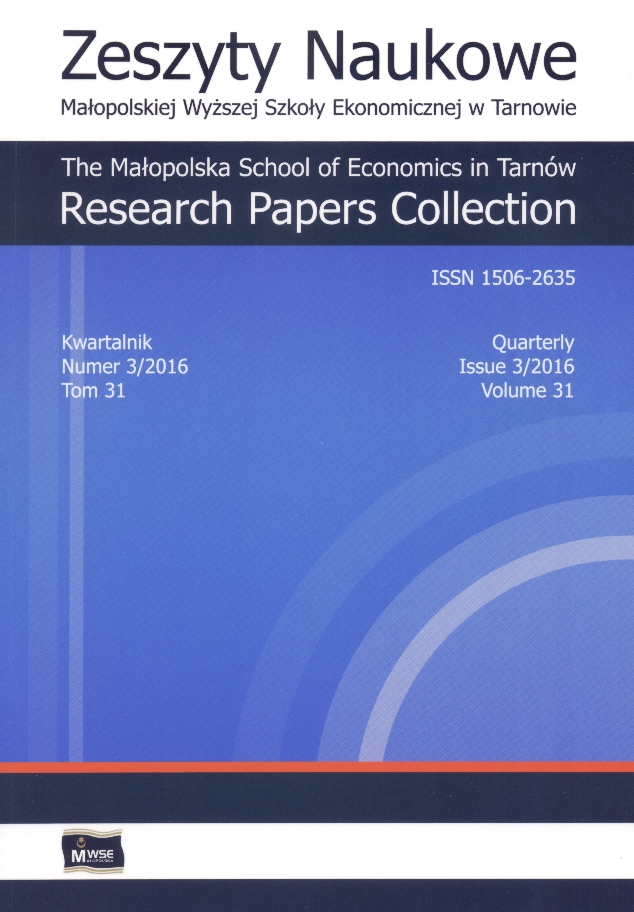Abstract
The aim of this article is to show the differences in the perception of the physical characteristics of the criteria by employers and employees, as well as the identification of areas and scope of these differences for the identification of needs to develop theoretical tools and formulas for practical cooperation in the creation of working conditions. The authors present the contemporary concepts of physical features of work from the point of view of work design as approached by management and ergonomics. The theoretical management model used in the study is the job characteristics concept by Grant, Fried, Juillerat, which, due to the criteria of physical characteristics was related to ergonomic criteria. On this basis, the authors present the results of the study, including the opinions of employees and employers. This made it possible to determine the field of differences in perceiving problems of the physical job characteristics by both groups of respondents and show their theoretical and practical consequences. Significant differences in the views of employers and employees in the area of the criteria for physical characteristics, identified in the research analysis, occur in relation to the psychosocial load and work environment. These criteria of physical characteristics are recognized by employers as less important than the level reported by employees. The presented conclusions are proposals to determine the directions of further research and practical solutions. Such targeted research will enable in future to close the gap between the views of the two groups in terms of health and life of employees.
References
Brown, O. Jr. (2002). Macroergonomic methods: participation. W: H.W. Hendrik, B.M. Kleiner (eds.). Macroergonomics: Theory, Methods, and Applications (s. 25–44). Mehwah: Lawrence Erlbaum Associates.
View in Google Scholar
Cordery, J., Parker, S.K. (2007). Work organization. W: P. Boxall, J. Purcell, P. Wright (eds.). Oxford Handbook of Human Resource Management (s. 187–209). New York: Oxford University Press. ISBN 9780199282517.
View in Google Scholar
Cullinane, S.-J., Bosak, J., Flood, P.C., Demerouti, E. (2013). Job design under lean manufacturing and its impact on employee outcomes. Organizational Psychology Review, 3(1), 41–61. Doi:10.1177/2041386612456412.
View in Google Scholar
Grant, A.M., Fried, Y., Juillerat, T.L. (2011). Work matters: Job design in classic and contemporary perspectives. W: S. Zedeck (ed.). APA Handbook of Industrial and Organizational Psychology. Vol. 1: Building and Developing the Organization (s. 417–453). Washington, DC: American Psychological Association. ISBN 978-1-4338-0727-5.
View in Google Scholar
Grant, A.M., Parker, S. (2009). 7 redesigning work design theories: The rise of relational and proactive perspectives. The Academy of Management Annals, 3(1), 317–375. Doi: 10.1080/19416520903047327.
View in Google Scholar
Jasiak, A., Misztal, A. (2004). Makroergonomia i projektowanie makroergonomiczne. Poznań: Wydawnictwo Politechniki Poznańskiej. ISBN 83-7143-471-5.
View in Google Scholar
Jasiak, A., Pacholski, L., Prussak, W., Spychala, M., Tytyk, E. (1986–1988). Projekt Polskiej Normy PN-88/N-08007 Ergonomiczna atestacja maszyn i urządzeń. Podstawy metodyczne. Poznań: Instytut Organizacji Zarządzania Politechniki Poznańskiej.
View in Google Scholar
Lis, K. (2012). The labour market and material environment design. W: 4th International Conference on Applied Human Factors and Ergonomics (AHFE) (s. 3521–3530). Louisville: USA Publishing. ISBN 978-0-9796435-5-2.
View in Google Scholar
Morgeson, F.P., Campion, M.A. (2003). Work design. W: W.C. Borman, D.R. Ilgen, R.J. Klimoski (eds.). Handbook of Psychology: Industrial and Organizational Psychology. Vol. 12 (s. 423–452). Hoboken: John Wiley & Sons. ISBN 0-471-38320-1.
View in Google Scholar
Morgeson, F.P., Garza, A.S., Campion, M.A. (2012). Work design. W: N. Schmitt, S. Highhouse (eds.). Handbook of Psychology: Industrial and Organizational Psychology. Vol. 12 (s. 525–559). 2nd ed. Hoboken: John Wiley & Sons. ISBN 978-0-470-76887-7.
View in Google Scholar
Morgeson, F.P., Humphrey, S.E. (2008). Job and team design: Toward a more integrative conceptualization of work design. W: J.J. Martocchio (ed.). Research in Personnel and Human Resources Management, 27 (s. 39–91). ISBN 978-1-84855-004-9.
View in Google Scholar
Olszewski, J. (2013). System pracy w warunkach globalnego społeczeństwa informacyjnego. Poznań: Wydawnictwo Uniwersytetu Ekonomicznego. ISBN 978-83-7417-775-7.
View in Google Scholar
Pacholski, L., Jasiak, A. (2011). Makroergonomia. Poznań: Wydawnictwo Politechniki Poznańskiej. ISBN 978-83-7775-045-2.
View in Google Scholar
Parker, S.K., Ohly, S. (2008). Designing motivating jobs: An expanded framework for linking work to motivation. W: R. Kanfer, G. Chen, R.D. Pritchard (eds.). Work Motivation: Past, Present and Future (s. 233–284). New York; Abingdon: Routledge. ISBN 978-0805857450.
View in Google Scholar
Rymaniak, J. (2015). Współczesne cechy pracy: koncepcja teoretyczna i weryfikacja empiryczna. W: M. Makowiec (red.). Wybrane problemy w kształtowaniu zachowań organizacyjnych (s. 15–22). Kraków: Uniwersytet Ekonomiczny. ISBN 978-83-941580-2-6.
View in Google Scholar
Rymaniak, J. (2016). Contemporary labour and human resources management as seen by the production sector and the judiciary employees. W: Advances in Human Factors, Business Management, Training and Education (s. 1173–1184). Proceedings of the AHFE 2016 International Conference on Human Factors, Business Management and Society, July 27–31, 2016, Walt Disney World®, Florida, USA. Springer. ISBN 978-3-319-42069-1.
View in Google Scholar
Tytyk, E. (2001). Projektowanie ergonomiczne. Warszawa; Poznań: Wydawnictwo Naukowe PWN. ISBN 83-01-13611-12.
View in Google Scholar
Vink, P., Koningsveld, E.A.P., Molenbroek, J.F. (2006). Positive outcomes of participatory ergonomics in terms of higher comfort and productivity. Applied Ergonomics, 37, 537–546.
View in Google Scholar
Wieczorkowska-Wierzbińska, G., Wierzbiński, J., Król, G. (2015). Metody ilościowe. W: M. Kostera (red.). Metody badawcze w zarządzaniu humanistycznym (s. 176–177). Warszawa: Wydawnictwo Akademickie Sedno. ISBN 978-83-7963-010-3.
View in Google Scholar
© Copyright by Małopolska School of Economics in Tarnów. The articles are available under the Creative Commons Attribution NonCommercial-NoDerivatives 4.0 International License


